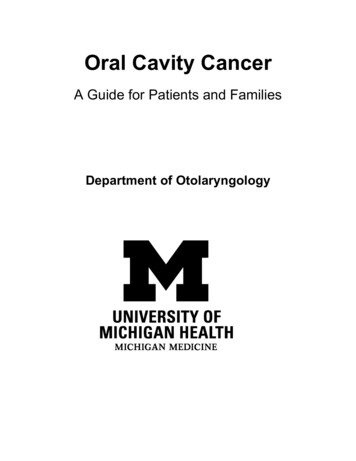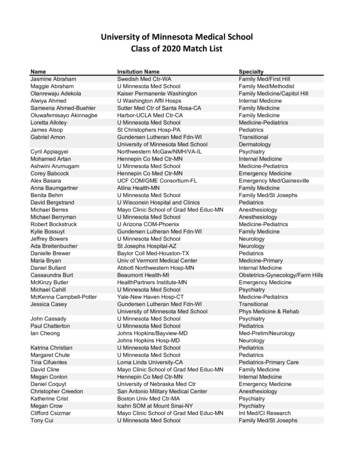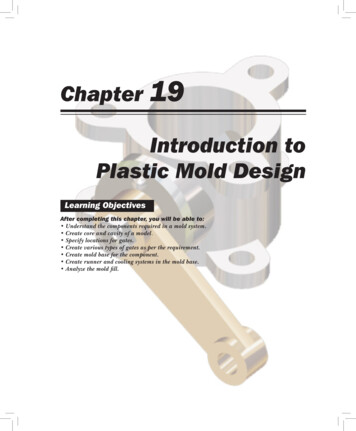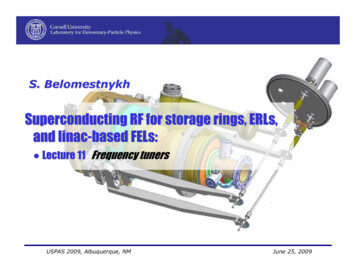
Transcription
Oral Cavity CancerA Guide for Patients and FamiliesDepartment of Otolaryngology
IntroductionA team of doctors at the University of Michigan HealthOtolaryngology Clinic wrote this booklet for people who have adiagnosis of oral cavity cancer, also known as mouth or oral cancer,and for the family members and friends who care about them. Thepurpose of this booklet is to give answers to questions about thecancer treatment and recovery process and about what you canexpect from your surgery. If you have any additional questions,please ask an Otolaryngology clinic member.Table of Contents:Oral Cavity Cancer.3What is oral cavity cancer?.3What is reconstructive surgery?.4Post-Operative Recovery.9Time in the hospital .9Post-operative complications .11Discharge to home or rehabilitation facility.15Your pathology report . 15Life After Cancer Treatment.16Cancer survivorship .17Conclusion.19Department of OtolaryngologyOral Cavity Cancer-2-
Oral Cavity CancerWhat is oral cavity cancer?Oral cavity cancer, also known as mouth or oral cancer, typically starts as alump, bump, or patch in the mouth. The oral cavity has multiple parts, whichinclude: Lips Oral tongue Buccal mucosa Retromolar trigone(small area behind thewisdom teeth) Alveolar ridge (ridge inthe center of the roof ofthe mouth) Hard palate Floor of mouthThe oral cavity is made up of flat, thin squamous cells that line the mouth andthroat. Squamous cells are flat cells that looks like a fish scale under amicroscope. Almost all the cancers in the oral cavity are squamous cellcarcinomas. Carcinoma means cancer that begins in the skin or in tissues thatline or cover internal organs. Excessive tobacco and alcohol use both contributeto squamous cell carcinomas. Common symptoms include: Painful sores or ulcers in the mouth Bleeding from the mouth Numbness in the mouth or chin Difficultly opening the mouth or speaking Bad breath.Department of OtolaryngologyOral Cavity Cancer-3-
How is oral cavity cancer diagnosed?A biopsy (tissue sample) is necessary to confirm that the lesion (abnormaltissue) is cancer. This can either take place in clinic if the lesion is easilyaccessible and the risk of bleeding is low or in the operating room. Furtherevaluation with a Magnetic Resonance Imaging (MRI) or Computed Tomography(CT) scan may be required to determine if the cancer has spread to nearbylymph nodes or distant sites such as the lungs.What is the treatment?The treatment for oral cavity cancer is usually surgery, sometimes followed bychemotherapy and radiation treatment.Your case will be presented at our Multidisciplinary Tumor Board, which is alarge conference where doctors review your case and determine the finaltreatment plan. This board includes: Cancer surgeons Oncologists (doctors with special training in diagnosing and treatingcancer) Radiation oncologists (doctors with special training in treating cancerwith radiation) Pathologists (doctors with special training in identifying diseases) Radiologists (doctors with special training in creating and interpretingmedical pictures of the body using x-rays, or other imaging tests)What is reconstructive surgery?The goal of reconstructive surgery is to restore function to tissue affected bycancer. If the defect is small, then the wound can be closed by simply stitchingor stapling the skin back together. For larger affected areas, a split-thickness orfull-thickness skin graft can be used. Grafts are pieces of tissue taken from onepart of the body and moved to another to resurface defects that are surfaceDepartment of OtolaryngologyOral Cavity Cancer-4-
level. However, if the lesion is deep and a bulkier type of tissue is needed, thena free flap from various parts of the body is the best option. A free flap is apiece of tissue with its blood vessels, skin, fat, and sometimes muscle, that isremoved and attached to another part of the body. Common free flaps used toreconstruct oral cavity defects are listed below:Radial/ulnar artery forearm free flap (RFFF/UFFF)The radial forearm flap is taken from the forearm. It is one of the mostcommon free flaps used today for head and neck reconstruction because it is: Thin Easy to harvest Able to be used for multiple types of defects Has a long vascular pedicle (blood supply)Using this flap also requires a skin graft to resurface the skin of the forearmwhere the flap was taken. A device called a wound vacuum will then be placedon top of the skin graft. A wound vacuum uses a foam bandage and a vacuumpump to decrease pressure on the wound. It pulls the edges of the woundtogether to speed up healing. Your arm will be placed in a special splint aftersurgery to help the skin graft heal properly.Below: Tongue defects reconstructed with radial and ulnar artery free flaps. Yu P, Robb GL. Clin Plast Surg. 2005. Open Access Atlas of OtolaryngologyDepartment of OtolaryngologyOral Cavity Cancer-5-
Latissimus dorsi muscle (LAT) free flapThe latissimus dorsi muscle is the largest muscle in the body, allowing for it tobe used to reconstruct large defects. It is located on both sides of the uppertorso. It can also be combined with the other muscle flaps and flaps that havebone attached in the same region. The place this flap is taken from is closedprimarily with stiches or staples, and at least 2 drains will be secured in place.Below: the latissimus dorsi muscle shown on the back of the body.OpenStax College, CC BY 3.0, via Wikimedia CommonsAnterolateral thigh (ALT) free flapThe anterolateral thigh (ALT) flap is a versatile flap that may be used for anydefect that requires soft tissue reconstruction with skin, fascia, or muscle. Thisflap can be used to rebuild your entire tongue if your cancer involves most ofyour tongue and requires a total tongue removal (total glossectomy).Department of OtolaryngologyOral Cavity Cancer-6-
Below: Total tongue defect reconstructed with an ALT free flap Di Candia M et al. Eplasty. 2012.Fibula free flapThe fibula bone is the outer lower leg bone that is paired with the tibia, whichis the main lower leg bone. Its main function is to help support and stabilizethe ankle. It does not bear weight, so a segment can be removed without longterm impacts on standing, walking, or running. The fibula free flap is used ifyour oral cancer involves your jawbone (mandible) and needs to be removed tofully remove your cancer.Below: the fibula bone is show on the front of the body in red.
Anatomography, CC BY-SA 2.1 JP via Wikimedia CommonsBelow: The fibula flapTracheostomyFor some reconstructive surgeries, a temporary tracheostomy tube may beplaced in your trachea (windpipe) to help you breathe. You will have significantswelling in your mouth both from the surgery and your flap reconstruction,making it hard to breathe, so the tracheostomy tube will bypass the blockage ofairflow.Below: tracheostomy tube partsDepartment of OtolaryngologyOral Cavity Cancer-8-
Below: 6-0 cuffed Shiley tracheostomy tube Medtronic 2019. All rights reserved.Post-Operative RecoveryTime in the hospitalThe first night after your surgery will be challenging as you adjust to: The initial shock of undergoing a long 8-hour surgery Having a new tracheostomy (if applicable) Awakening from anesthesia Sleeping poorlyOur team is here to support you during this time. Your pain will be controlledwith opioid medications and you will have hourly check-ups and flap checks byyour nurse and our overnight call resident (doctor getting advanced training).Common milestones on the first post-operative day: Starting nutrition through the feeding tube in your nose or stomach Removing the Foley catheter from your bladder Deflating the balloon (cuff) on your tracheostomy tube if you have oneDepartment of OtolaryngologyOral Cavity Cancer-9-
Deflating the balloon (cuff) on your trach tube will make you cough and makeyou uncomfortable, but this is normal. Focus on slow, deep breathing exercises.Between 3-5 days after surgery, your cuffed tracheostomy tube will be changedto a more comfortable tracheostomy tube without a cuff (cuffless). This willeither be the same size or a size smaller.It is important that you tell your nurse if you are having nausea or vomitingwhen starting your tube feedings. If you are not able to tolerate them, there aretube feeding formulas that you may tolerate better. Our team can also orderanti-nausea medications.You will have drains in your neck or extremities to remove fluid depending onthe type of surgery you needed. These will usually be removed when theoutputs are lower than 30 milliliters in 24 hours. However, some drains willstay longer than others in order to monitor for a new infection or if the outputis too high to be removed at the time of discharge. Most people go home with atleast 1-2 drains, especially if the drains are in the leg (ALT/fibula free flap) orback (LAT free flap). You will learn to move around with them attached and youwill learn how to measure and care for the drains.Below: Jackson-Pratt (JP) drains, large and small bulb, that are used for headand neck surgery patientsDepartment of OtolaryngologyOral Cavity Cancer- 10 -
Common post-operative complicationsHematomaA hematoma is a collection of blood that commonly forms after surgery. It isusually caused by slow oozing of blood from a vein in the surgical area or byactive bleeding from an artery where a surgical clip failed. If the hematoma issmall, then it can be managed with an ace bandage. If it is large or rapidlyexpanding (an active artery bleed), then it will require an additional surgery.Flap problemsYour flap is reconstructing the area of your previous cancer with an artery andvein. Problems with the artery or the vein can happen at any point during yourhospital stay, however they are most likely to happen within the first 3 daysafter surgery. Therefore, your flap is monitored by your nurse with a Dopplermachine (ultrasound) every hour for the first 3 days after your surgery. If aproblem with the artery or vein is discovered, then you need to return to theoperating room urgently for an additional surgery. In rare cases, your originalflap may not be able to be fixed, so you will need a new flap with a new arteryand vein for reconstruction.Wound infection or openingYour surgical incisions may become infected or begin to breakdown a few daysafter surgery. Signs of infection include: Fever Chills Pus drainage Pain redness Bad smell coming from the woundInfections are treated with antibiotics. Wound openings are treated with woundpacking 2-3 times per day or a wound vacuum to help it close. There are timesDepartment of OtolaryngologyOral Cavity Cancer- 11 -
when the wound is partially closed on purpose, and the remainder is left opento pack or place a wound vacuum.Pharyngocutaneous fistulaLike a wound opening, a pharyngocutaneous fistula occurs when a connectionforms between the underside of your tongue, or the back of your throat(pharynx), and your external neck skin. Saliva will either drain into yourJackson-Pratt (JP) drains in your neck or through a wound opening. This can bemanaged with an Ace bandage and antibiotics, which will help seal or close theconnection. Your JP drains may be removed and replaced with red rubbercatheters (flexible tubes) that are stitched in place. These are irrigated 3-4 timesdaily with Chlorpactin (very dilute bleach) to thoroughly clean your wound.Tracheostomy mucous pluggingYour tracheostomy tube can become plugged with mucous if your secretionsbecome too thick. We can thin the secretions in two ways: Oxygen with added humidity (moisture) through a tracheostomy mask Saline rinsing through your tracheostomy tubeHowever, mucous plugs still form despite these therapies. You will have troublebreathing if there is a mucous plug and your nurse will be able to recognize thisissue immediately.1. The first step to clear the plug is to perform a saline irrigation with suction.2. If that is unsuccessful, then your nurse will change your tracheostomy tubeinner cannula (tube).3. If that is unsuccessful, then your nurse will page the overnight call residentwho will place a scope down your tracheostomy tube to see the plug anddetermine how much room you have to breathe.4. In rare cases, your tracheostomy tube will need to be taken out to remove alarge mucous plug.Department of OtolaryngologyOral Cavity Cancer- 12 -
PneumoniaLung infections called pneumonia can occur after surgery. Signs and symptomsinclude: Fever Chills Coughing up pus Low oxygen in your blood Chest painPneumonia is treated with antibiotics and extra oxygen as needed.Deep vein thrombosis (DVT) and pulmonary embolismA deep vein thrombosis (DVT) is a blood clot in the deep veins of the arms andlegs. A pulmonary embolism is a blood clot or in the arteries of the lung(pulmonary arteries). Signs of a DVT include one-sided swelling and pain of the arm or leg. Signs of a pulmonary embolism are increased oxygen needed due to lowoxygen in the blood, increased heart rate, and chest pain.You are placed on medicine to help prevent DVTs, such as subcutaneous(administered into fatty tissue) Heparin and Lovenox, but they can still occurwhile taking these medications. If you are diagnosed with a blood clot in yourarm or leg or lung, then you will be treated with a heparin infusion to thin yourblood and prevent further formation of blood clots.Urinary retentionYou will have a Foley catheter (flexible tube) placed through your urethra andinto your bladder at the start of your surgery to accurately monitor your urineoutput. It is kept in place after surgery and will usually be removed the nextday. We will then monitor your urine output without the Foley.Department of OtolaryngologyOral Cavity Cancer- 13 -
If you are not able to urinate within the first 6 hours, then we will scan yourbladder to determine if your bladder is retaining (holding) urine. If there is greater than 250 ml of urine in your bladder, then we will drainyour bladder with a straight disposable catheter. If you require more than 4 straight catheters in a row, then your Foley willbe reinserted.Your bladder is like a balloon that will keep filling with urine and can pop dueto high pressures if it is not drained.Alcohol withdrawalIf you drink large amounts of alcohol daily before surgery, then your body maycrave this same amount of alcohol after surgery since you are not able to drinkin the hospital. This is called withdrawal. Signs that your body is cravingalcohol and going through withdrawal include: Tremors Sweating Trouble sleeping Anxiety Agitation Confusion Increased heart rate Increased blood pressure HallucinationsThese symptoms require frequent medications. You may need to be transferredto the Intensive Care Unit (ICU) for closer monitoring and infusion ofmedications that are only available in the ICU. Alcohol withdrawal is seriousand can be fatal. Please tell your surgeon if you drink large amounts of alcoholdaily.Department of OtolaryngologyOral Cavity Cancer- 14 -
Discharge to home or rehabilitation facilityYour road to recovery and healing continues while you are at home or yourrehabilitation center. At this point, you and your family have learned how toadminister tube feedings, take of your tracheostomy, and care for wounds.Nursing staff at your facility have also been trained in these areas.If you have questions about your care once you leave the hospital, this isnormal. An emergency help line number was printed out on your dischargepaperwork, so you can speak to one of our excellent residents and they willhelp you troubleshoot your problem and determine if you need to return to thehospital for further evaluation.Call the help line if you notice any of these symptoms: Your feeding tube becomes clogged You notice neck swelling or a foul smell from your incision You start to bleed from your mouth Your tracheostomy tube comes out accidentallyAdditionally, you will have a video visit with one of our nurse practitioners 2-4days after you leave the hospital to make sure you are doing well. You will alsoreturn to clinic several times to: Ensure proper healing Remove neck sutures Remove drains Allow you to drink water for the first time since the night before surgery And moreYour Pathology ReportAfter surgery, your cancer is evaluated under the microscope by a doctor whospecializes in pathology (disease cause and effect). Your pathology report willDepartment of OtolaryngologyOral Cavity Cancer- 15 -
be shared once it is available and your surgeon will review it with you and yourfamily. Your pathology report includes information about: Your cancer type How aggressive the cancer is The spread of the cancer If the tumor was completely removedIt is important for the doctors to ensure that they have removed all of thecancer at the time of surgery. This is done by also removing a rim of normaltissue at the edge of the tumor, which is called the surgical margin. Afterreviewing the pathology report, you will be referred for consideration ofchemotherapy and radiation after surgery if: Your cancer was large and aggressive The rim of normal tissue at the edge of the removed tumor (surgicalmargin) shows cancer cells under the microscope Cancer spread to multiple lymph nodes in your neck The cancer in your lymph nodes is growing outside of the lymph node(extranodal extension)Life After Cancer TreatmentYou should visit your surgeon, radiation oncologist, or medical oncologist on aregular schedule or earlier if you have any concerning symptoms. Aftertreatment, you will see your cancer provider every: 1-3 months during the first year 3-6 months during the second year 6-8 months during the third and fourth year Once per year after 5 yearsDuring these appointments, you will be evaluated for cancer recurrence. Youwill also need imaging studies for cancer surveillance, such as chest X-ray, CT,Department of OtolaryngologyOral Cavity Cancer- 16 -
MRI, or PET scan. If something suspicious comes up, then you will need abiopsy.Cancer SurvivorshipOncologic surveillance / second primary screeningYou will have frequent physical exams in clinic during your first 5 years aftertreatment (schedule outline above) to look for recurrent cancer at or near yourprevious site of cancer. Additionally, you will likely have imaging of your chestevery year to look for distant spread of your cancer to your lungs.Dental careYou should go to the dentist at least twice per year for check-up exams orcleanings after surgery or radiation. You should also use high-dose fluoride onyour teeth daily; this can be with toothpaste or a mouthwash.Carotid stenosis screeningYou will have a duplex scan (ultrasound) every 2 years after radiation to checkfor artery narrowing from radiation that can increase your risk for stroke(blood not getting to your brain). If the artery becomes too narrow, then we willrefer you to Vascular Surgery for further evaluation.Speech/swallowingSpeech and swallowing are often abnormal after head and neck cancertreatment. Speech Language Pathology (SLP) services are provided at our clinic.These services are important to increase hydration and lubrication for drymouth (xerostomia) as well as breath support for an optimal voice.Hypothyroidism due to radiationYour cancer provider or primary care doctor will monitor your ThyroidStimulating Hormone (TSH) levels every 6-12 months. You may require thyroidDepartment of OtolaryngologyOral Cavity Cancer- 17 -
hormone supplementation permanently. Signs and symptoms ofhypothyroidism include: Feeling colder Tired Dry/brittle skin and nails Depression ConstipationSleep behaviorsSleep patterns can change and the risk for obstructive sleep apnea (OSA) afterhead and neck cancer treatment is increased. Please be sure to tell your cancerprovider if you have concerns regarding your sleep.DepressionDepression is also common after head and neck cancer diagnosis andtreatment, so we encourage you to tell your cancer provider or primary caredoctor about your depression. Ask your doctor for resources and referrals ontreating your depression.Substance useQuit smoking tobacco and drinking alcohol and do not restart, if possible, toreduce the risk of cancer recurrence. Ask your doctor for resources to helptreat tobacco and/or alcohol addiction.Neck pain, shoulder pain or fibrosisRange of motion exercises are encouraged, Physical Therapy and OccupationalTherapy (PT/OT) services are available to you as needed. Ask your doctor howto find these services.Department of OtolaryngologyOral Cavity Cancer- 18 -
In ClosingWe hope that this booklet has provided you with some useful answers, butplease feel free to ask us additional questions as they come up. Feel free to usethe lines below for noting anything you might want to ask about later.Disclaimer: This document contains information and/or instructional materials developed by theUniversity of Michigan Health for the typical patient with your condition. It may include links toonline content that was not created by University of Michigan Health and for which University ofMichigan Health does not assume responsibility. It does not replace medical advice from your healthcare provider because your experience may differ from that of the typical patient. Talk to your healthcare provider if you have any questions about this document, your condition or your treatment plan.Author: Shannon, Fayson, MDReviewers: Julianne, Szczepanski, MDPatient Education by University of Michigan Health is licensed under a Creative Commons AttributionNonCommercial-ShareAlike 4.0 International Public License. Last revised: 09/2021Department of OtolaryngologyOral Cavity Cancer- 19 -
The treatment for oral cavity cancer is usually surgery, sometimes followed by chemotherapy and radiation treatment. Your case will be presented at our Multidisciplinary Tumor Board, which is a large conference where doctors review your case and determine the fi










